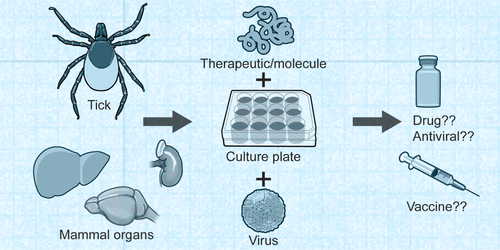当前位置:
X-MOL 学术
›
ACS Infect. Dis.
›
论文详情
Our official English website, www.x-mol.net, welcomes your
feedback! (Note: you will need to create a separate account there.)
The Use of Ex Vivo Organ Cultures in Tick-Borne Virus Research
ACS Infectious Diseases ( IF 4.0 ) Pub Date : 2018-02-23 00:00:00 , DOI: 10.1021/acsinfecdis.7b00274 Jeffrey M. Grabowski 1 , Danielle K. Offerdahl 1 , Marshall E. Bloom 1
ACS Infectious Diseases ( IF 4.0 ) Pub Date : 2018-02-23 00:00:00 , DOI: 10.1021/acsinfecdis.7b00274 Jeffrey M. Grabowski 1 , Danielle K. Offerdahl 1 , Marshall E. Bloom 1
Affiliation

|
Each year there are more than 15 000 cases of human disease caused by infections with tick-borne viruses (TBVs). These illnesses occur worldwide and can range from very mild illness to severe encephalitis and hemorrhagic fever. Although TBVs are currently identified as neglected vector-borne pathogens and receive less attention than mosquito-borne viruses, TBVs are expanding into new regions, and infection rates are increasing. Furthermore, effective vaccines, diagnostic tools, and other countermeasures are limited. The application of contemporary technologies to TBV infections presents an excellent opportunity to develop improved, effective countermeasures. Experimental tick and mammal models of infection can be used to characterize determinants of infection, transmission, and virulence and to test candidate countermeasures. The use of ex vivo tick cultures in TBV research provides a unique way to look at infection in specific tick organs. Mammal ex vivo organ slice and, more recently, organoid cultures are additional models that can be used to elucidate direct tissue-specific responses to infection. These ex vivo model systems are convenient for testing methods involving transcript knockdown and small molecules under tightly controlled conditions. They can also be combined with in vitro and in vivo studies to tease out possible host factors and potential vaccine or therapeutic candidates. In this brief perspective, we describe how ex vivo cultures can be combined with modern technologies to advance research on TBV infections.
中文翻译:

体内器官培养在T虫病毒研究中的应用
每年有超过15,000例由tick传病毒(TBV)感染引起的人类疾病病例。这些疾病在世界范围内发生,范围从非常轻微的疾病到严重的脑炎和出血热。尽管目前已将TBV识别为被忽略的媒介传播病原体,与蚊子传播的病毒相比,TBV受到的关注较少,但TBV正在扩展到新的地区,并且感染率正在增加。此外,有效的疫苗,诊断工具和其他对策也受到限制。将现代技术应用于TBV感染为开发改进的有效对策提供了绝佳的机会。实验性tick和哺乳动物感染模型可用于表征感染,传播和毒力的决定因素,并测试候选对策。TBV研究中离体tick文化的使用提供了一种独特的方式来查看特定tick器官中的感染。哺乳动物离体器官切片和最近的类器官培养是可用于阐明对感染的直接组织特异性反应的其他模型。这些离体模型系统便于在严格控制的条件下进行涉及转录本敲低和小分子的测试方法。它们也可以与体外和体内研究相结合,以找出可能的宿主因子和潜在的疫苗或治疗候选物。在这个简短的观点中,我们描述了离体培养物如何与现代技术相结合以推进对TBV感染的研究。类器官培养物是可用于阐明对感染的直接组织特异性反应的其他模型。这些离体模型系统便于在严格控制的条件下进行涉及转录本敲低和小分子的测试方法。它们也可以与体外和体内研究相结合,以找出可能的宿主因子和潜在的疫苗或治疗候选物。在这个简短的观点中,我们描述了离体培养物如何与现代技术相结合以推进对TBV感染的研究。类器官培养物是可用于阐明对感染的直接组织特异性反应的其他模型。这些离体模型系统便于在严格控制的条件下进行涉及转录本敲低和小分子的测试方法。它们也可以与体外和体内研究相结合,以找出可能的宿主因子和潜在的疫苗或治疗候选物。在这个简短的观点中,我们描述了离体培养物如何与现代技术相结合以推进对TBV感染的研究。它们也可以与体外和体内研究相结合,以找出可能的宿主因子和潜在的疫苗或治疗候选物。在这个简短的观点中,我们描述了离体培养物如何与现代技术相结合以推进对TBV感染的研究。它们也可以与体外和体内研究相结合,以找出可能的宿主因子和潜在的疫苗或治疗候选物。在这个简短的观点中,我们描述了离体培养物如何与现代技术相结合以推进对TBV感染的研究。
更新日期:2018-02-23
中文翻译:

体内器官培养在T虫病毒研究中的应用
每年有超过15,000例由tick传病毒(TBV)感染引起的人类疾病病例。这些疾病在世界范围内发生,范围从非常轻微的疾病到严重的脑炎和出血热。尽管目前已将TBV识别为被忽略的媒介传播病原体,与蚊子传播的病毒相比,TBV受到的关注较少,但TBV正在扩展到新的地区,并且感染率正在增加。此外,有效的疫苗,诊断工具和其他对策也受到限制。将现代技术应用于TBV感染为开发改进的有效对策提供了绝佳的机会。实验性tick和哺乳动物感染模型可用于表征感染,传播和毒力的决定因素,并测试候选对策。TBV研究中离体tick文化的使用提供了一种独特的方式来查看特定tick器官中的感染。哺乳动物离体器官切片和最近的类器官培养是可用于阐明对感染的直接组织特异性反应的其他模型。这些离体模型系统便于在严格控制的条件下进行涉及转录本敲低和小分子的测试方法。它们也可以与体外和体内研究相结合,以找出可能的宿主因子和潜在的疫苗或治疗候选物。在这个简短的观点中,我们描述了离体培养物如何与现代技术相结合以推进对TBV感染的研究。类器官培养物是可用于阐明对感染的直接组织特异性反应的其他模型。这些离体模型系统便于在严格控制的条件下进行涉及转录本敲低和小分子的测试方法。它们也可以与体外和体内研究相结合,以找出可能的宿主因子和潜在的疫苗或治疗候选物。在这个简短的观点中,我们描述了离体培养物如何与现代技术相结合以推进对TBV感染的研究。类器官培养物是可用于阐明对感染的直接组织特异性反应的其他模型。这些离体模型系统便于在严格控制的条件下进行涉及转录本敲低和小分子的测试方法。它们也可以与体外和体内研究相结合,以找出可能的宿主因子和潜在的疫苗或治疗候选物。在这个简短的观点中,我们描述了离体培养物如何与现代技术相结合以推进对TBV感染的研究。它们也可以与体外和体内研究相结合,以找出可能的宿主因子和潜在的疫苗或治疗候选物。在这个简短的观点中,我们描述了离体培养物如何与现代技术相结合以推进对TBV感染的研究。它们也可以与体外和体内研究相结合,以找出可能的宿主因子和潜在的疫苗或治疗候选物。在这个简短的观点中,我们描述了离体培养物如何与现代技术相结合以推进对TBV感染的研究。











































 京公网安备 11010802027423号
京公网安备 11010802027423号